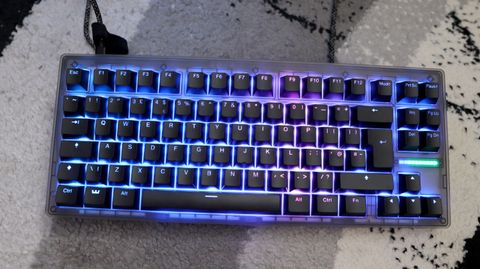Our Verdict
The Wooting 80HE makes for a capable gaming keyboard with lots of power and a meaner look, although at the expense of a chassis with some flex.
For
- Hilariously powerful Hall effect switches
- Meaner looks
- Lightweight, web-based software
Against
- Nerfed Snappy Tappy, Rappy Tappy
- Chassis has some flex
PC Gamer's got your back
The Wooting 80HE has been arguably one of the most hotly anticipated gaming keyboards of 2024, offering a larger form factor choice that packs in some of the most powerful keyswitches I've experienced in a gaming keyboard that comes with analogue capabilities for progressive inputs and rapid trigger functionality for super-speedy actuation. Not to mention, there are also Wooting's Snappy Tappy and Rappy Tappy functions.
Essentially, this is the Mickey's Kitchen Sink Sundae of gaming keyboards in 2024.
A lot of the 80HE's clever functionality is thanks to the Dutch brand's new Lekker V2 switches, which offer notable improvements such as less key wobble, better acoustics and even more lubrication. They're quite simply fantastic for gaming, and are seriously powerful in combination with the technical wizardry Wooting has been putting into keyboards for years.
My sample came with the slightly heavier Lekker60 variant, which feel as if they have a bit more substance to them than the lighter Hall effect switches I've used in other 'boards in the past. You can get it with 45g switches, if you'd prefer something lighter, though.
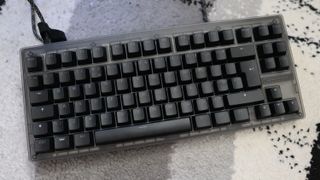
Switch type: Wooting Lekker60 V2
Keycaps: PBT, double-shot
Lighting: RGB, controllable in software
Onboard storage: Yes
Extra ports: USB-C for wired operation
Connection type: Wired, USB-C
Cable: USB Type-C/USB Type-A, detachable
Weight: 1.8 kg/3.986 lbs
Price: $200/£184
As these are analogue, Hall effect switches, you get the benefit of both rapid trigger for virtually instant actuation and reset for super speedy inputs and progressive keypresses to allow the 80HE to mimic a controller in racing games or FPS titles where you want more control. These two features are still allowed in the likes of CS2, and make a tangible difference to the overall speed of inputs, as long as you've got solid reaction times.
Rapid trigger is the standout inclusion for me here, simply on how brisk it makes those inputs. That goes for everything from drawing weapons to simple movement using WASD, and it helps the 80HE feel wildly responsive. What's also handy about the rapid trigger functionality on the 80HE is that you can set the actuation as high as 0.1 mm. For reference, the standard actuation point on a normal mechanical switch is 2 mm, making it notably quicker, and turns your keyboard's switches into hair triggers.
The analogue capabilities here are better for racing games, as it provides controller-like inputs on a keyboard. It's with this function that Wooting first made a name for itself back in 2017, and still remains a core part of its switches. This proved handy in some playthroughs of Forza Horizon 5 when I wanted to test out a time trial using both a controller and the 80HE. Naturally, I was quicker on the controller given my innate familiarity, although it was intriguing to use WASD as you would triggers and analogue sticks.
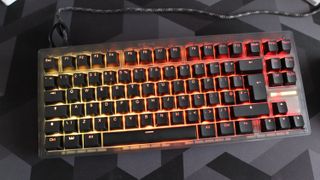
The 80HE is fully wired for a zero-latency input, and also benefits from an 8000 Hz polling rate, for more frequent input reporting than bog-standard mechanical boards that have a 1000 Hz rate. In my experience, I didn't necessarily feel much of a difference, although the 80HE felt incredibly quick as it is, so a combination of the 8000 Hz polling rate and rapid trigger make it one of the quickest keyboards money can buy right out of the box. For pro players, the 8000 Hz polling rate is likely to make more of a difference where speed is everything in a competitive scenario.
The only thing to note about the 80HE's acoustics with those switches inside is that it can be quite loud, so if you're going to be using this keyboard in a crowded space for work and play, you may want to account for some complaints.
Then we come to the addition of the Snappy Tappy and Rappy Snappy modes. Admittedly, this is something I wasn't too keen on when it was first announced for Razer's boards. As it turns out, neither was Wooting, as it only made its way into the 80HE due to the result of a poll in which the community voted majorly in favour of SOCD-tech. Valve weren't very keen on it either, banning the tech in Counter Strike 2 in recent months.
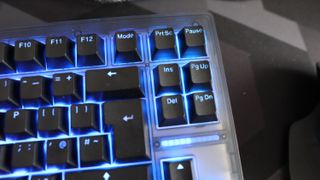
Essentially, SOCD (or Simultaneous Opposing Cardinal Directions) allows for especially quick movement without much effort, such as the fine art of counter-strafing in Counter Strike 2. The methods involved with the 80HE allow you to activate one key at will while holding the other down for unnaturally quick side-to-side movement if bound to the A and D keys, for instance, either based on the most recent input pressed or on whichever key is pushed down further. That's trying to explain it in its most basic form, and I still don't understand it. To this end, here's a handy feature where Jacob explains what SOCD is.
I couldn't test either one of Snappy Tappy or Rappy Snappy online in Counter-Strike 2, as it would result in a ban. However, I seemingly could test them in a single-player match against intermediate-difficulty bots, and it became abundantly clear how powerful this tech is. I'm not a great Counter-Strike player, only dabbling in the odd match here and there, but with the whole SOCD tech, it means anyone can move like the pros do. Of course, it isn't foolproof as you still need to be precise with aim and such, but it's a big helping hand for tactics such as 'jiggle strafing'.
The likes of polling rate, rapid trigger and those new SOCD features are controlled in Wooting's Wootility software, a lightweight web-based configurator. It's easy to use and to set up profiles for different tasks, such as typing and gaming. Wooting provides these two right out of the box, although you can add more if you wish. You can also fiddle with the board's bright RGB lighting here too on a per-key basis, although what's odd is that there isn't a means of programming and recording macros, which seemingly every other peripherals manufacturer has bundled into their software over the years. Nonetheless, Wootility helps keep things simple.
The 80HE is available in either pre-built or custom configurations, where you're given the PCB, and you have to choose your own case, keycaps and switches. The sample I have is in the pre-built camp, coming with the PCR plastic case in its special edition translucent 'Ghost' variant. That goes for $200/£186, which puts it firmly in the frame against both enthusiast-grade choices such as the Keychron Q3 Max, and other esports-grade choices including the aforementioned Razer Huntsman V3 Pro TKL.
Both of those options offer incredible build quality, whether they utilise a plastic or aluminium chassis. By contrast, the 80HE is quite bendy under load, with a bit of flex in the middle and at the case edges. It's not what I'd have expected for a keyboard at its price.
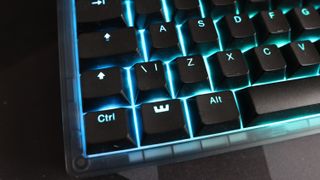
Maybe I'm being a bit nitpicky here, but the 80HE's method for changing the typing angle from completely flat up to ten degrees is a little, well, strange. Usually it's a case of having a pair of flip-out feet, or ones that attach with strong magnets. Wooting has stuck two fingers up to what makes sense, and instead gone for a pair of rubber pads which can be swapped out with other rubber pads to raise the angle up. It makes little sense, and while it gets the job done, isn't the most intuitive.
The layout is a halfway house between the seemingly ubiquitous 75 percent favoured by enthusiasts (including myself) and the more 'standard' TKL layout that's been around since the dawn of time. It offers a larger cluster of keys on the right hand side for more additional functionality, alongside the benefit of dedicated arrow keys and an F-row found on a 75% 'board. It's an easy layout to get used to, and makes sense for competitive players after a bit more desk space for big mouse movements.

✅ You want hilariously powerful switches: Even in spite of the forced omission of both Snappy Tappy and Rappy Tappy in some titles, the Wooting 80HE remains a seriously powerful keyboard with Hall effect switches that offer both rapid trigger and analogue capabilities.
❌ You want a sturdier chassis: Against other keyboards at similar prices, the 80HE offers a plastic chassis that suffers from some flex. It still looks cool, though.
In terms of good things about the 80HE's build quality and looks though, the translucent black case on this Ghost variant looks the business. It reminds me of the early noughties craze of translucent everything from iMacs to game controllers, and I swear it's the same shade of grey that my old OG Xbox MadCatz controller was back in the day.
The bundled keycaps are doubleshot PBT, and have a slight texturing to them, so feel excellent under finger. There is also an intriguing light bar above the arrow keys which adds a slither more RGB to proceedings, and can even be configured in the Wootility software to display everything from the profile selected to the level of key travel that's being inputted—handy.
So, to sum up then, the 80HE is a seriously powerful Hall effect keyboard with both analogue and rapid trigger functionality that certainly chunks in the kitchen sink for its features. I don't think the inclusion of SOCD tech makes it a damp squib, that's for sure. The software here is solid, and I like the way the 80HE looks, too. However, I can't help but feel short-changed by its flexilicous chassis for the $200/£184 asking price where more affordable options such as the Endgame Gear KB65HE provide an all-metal case and rapid trigger functionality for $139/£139. To be truthful, it depends on how much you value the overall feature set of the 80HE as to whether you should purchase one. For me, I'll stick with that lovely Q3 Max.
The Wooting 80HE makes for a capable gaming keyboard with lots of power and a meaner look, although at the expense of a chassis with some flex.
